
ASIAN GREENS: DEMYSTIFIED
09/23/16 — Heydon Hatcher
TGIF, y’all! If you’ve visited us at the farmers’ markets lately, you might have noticed the influx of leafy greens at our stand. Despite the steady face-melting temps, the crops are telling us that Fall is in fact on our doorstep. But, before you start pulling out your coziest Autumn sweaters in anticipation, let’s ponder a likely scenario... As you were perusing the medley of different greens this past weekend, grabbing a handful of kale, then moving onto the display of collards, you happen upon a mysterious and enticing bunch of greens. Perplexed by its shroud of enigma, you look around to your fellow market-goers for answers… What is it? Where did it come from? To your dismay, none of your market buddies know either! Fret not, farm friends, for what you most likely discovered was one of the many Asian greens that we have rolling out to market this season. This week, we hope to lay to rest some of your lingering inquiries, and make these puzzling and hard-to-identify leafy greens more accessible.
![Market greens. Photo by Scott David Gordon.]() Market greens. Photo by Scott David Gordon.
Market greens. Photo by Scott David Gordon.
We all know leafy greens are healthy... but why? Well, the nutritional value of the spectrum of dark, leafy greens boasts tons of potassium, folic acid, vitamin A, vitamin C, vitamin K, and the list goes on! Vegan or lactose intolerant? These greens are a great source of calcium and iron as well. Chock full of carotenoids, flavenoids + antioxidants, integrating any and all leafy greens into your diet can ultimately aid in immune function, and reduce your risk of heart disease, diabetes, and cancer. With tons of dietary fiber and low in calories, these veggies are great for weight maintenance, too. The USDA suggests that adults consume at least three cups of leafy greens per week, but with all that flavor, why not more? If these benefits aren’t a catalyst for you to step out of your “kale + collards comfort zone” (as Ada calls it) and explore the varying hues of green, we don’t know what else will!
![Bok choy. Photo by Scott David Gordon.]() Bok choy. Photo by Scott David Gordon.
Bok choy. Photo by Scott David Gordon.
Bok Choy - Translated directly from Cantonese, bok choy means ‘white vegetable’. Probably the most recognizable of all the Asian greens, this white-stemmed crop is a part of the Brassicaceae family (Fun fact: these guys are relatives of the turnip!) and also a type of Chinese cabbage. If you’ve been to a Chinese restaurant, you have probably seen this green offered on the menu as an ingredient augmenting a meaty dish or sauteed by itself. When cooking, the greens’ texture turns silky and the stems remain pretty crunchy. Ever had baby bok choy? This crop is delectable in any state of maturation. Grab a bunch of these mild greens next time you are at the market!
![Choi Sum. Photo by Scott David Gordon.]() Choi Sum. Photo by Scott David Gordon.
Choi Sum. Photo by Scott David Gordon.
Choi Sum - Identified most easily by it’s dainty (and ever-so-tasty) yellow blooms and long stems, it is also a part of the Brassicaceae fam. Translated as “vegetable stem” from Cantonese, choy sum boasts “a flavor between cabbage and spinach, sweet with a kick” says Mike Mo. A staff favorite here at JBG, this crop is great raw in a salad, stir-fried with other veggies, or a quick saute. If you want to impress your dinner guests, add the flowers to any salad. Not only is it a beautiful embellishment, but also a tasty addition. Check out the Staff Survey below for some recipe ideas.
![Tatsoi. Photo by Scott David Gordon.]() Tatsoi. Photo by Scott David Gordon.
Tatsoi. Photo by Scott David Gordon.
Tatsoi - With an aesthetic similar to that of a baby bok choy, these dark green and very round leaves with their mild taste have become increasingly popular in North American cuisine. Likened to spinach, tatsoi has an almost creamy texture when cooked. This tenacious little crop thrives in cooler temperatures, and can even survive below freezing! Our resident recipe-blogger delved into a cooking escapade with this green last week, check out this simple yet yummy dish!
![Komatsuna. Photo by Scott David Gordon.]() Komatsuna. Photo by Scott David Gordon.
Komatsuna. Photo by Scott David Gordon.
Komatsuna - Hailing from Japan, this crop translates literally as “greens of Komatsu” (fun fact: named after a town that used to heavily cultivate this leafy green in the 1600s, Komatsugawa). Sometimes confused for tatsoi, komatsuna has lighter green and glossier leaves, with thinner and longer stems. Otherwise known as Japanese mustard spinach, this vegetable is great steamed or added to a salad.
![Braising Mix. Photo by Scott David Gordon.]() Braising Mix. Photo by Scott David Gordon.
Braising Mix. Photo by Scott David Gordon.
Braising Mix - We know that this little bag of unidentifiable greens can sometimes be daunting, but this mixture of leafy deliciousness could add tons of flavor to a soup, or just dump it out and eat it raw, simple as that! The perfect amalgam of mild and spicy, this power-green combo is a mix of red mustard, green mustard, tatsoi, and Chinese cabbage.
![Hon Tsai Tai. Photo by Scott David Gordon.]() Hon Tsai Tai. Photo by Scott David Gordon.
Hon Tsai Tai. Photo by Scott David Gordon.
Hon Tsai Tai - Identified most easily by it’s long, purple-y stems, hon tsai tai has a slightly sweet, mild taste. Like choi sum, this crop grows beautiful and sweet little yellow flowers that you will sometimes spot when you are sifting through the bin at market. This fun-to-say crop could be the new champion of your signature salad or soup! Give it a try!
Still confused? We hear ya, it can be super bewildering, but hopefully we painted a more understandable picture of the plethora of Asian greens we offer. If you are overwhelmed by all the recipes and are having a hard time utilizing any of the aforementioned greens, just treat ‘em like spinach (that’s what we do)!
![Photo by Scott David Gordon.]() Photo by Scott David Gordon.
Photo by Scott David Gordon.
Staff Survey: What is your favorite Asian green, and how do you use it?
Matt: Choi sum. I was eating the flowers raw last weekend. Tastes like broccoli. Great stir fried with other veggies.
Tracy: Braising mix. On a sandwich with horseradish white cheddar, spicy brown mustard, ham and pepperoni with a generous bed of braising mix. Super spicy!
Ada: Choi sum. Super quick saute, beginning with stems and followed by leaves and flowers. Quick dash of soy, squeeze of lemon, and black pepper. Put on everything, or eat alone. YUM.
Charlotte: I second Ada and Matt! Choi sum, raw or sauteed is mind-blowing.
Ciara Peacock: I like using the big Bok Choy leaves to make wraps, as an alternative to tortillas. So sturdy and flavorful!
Save the date! Don’t miss our CSA Members Only Potluck on 10/22 and a Farm Tour with Slow Food Austin on 10/23!
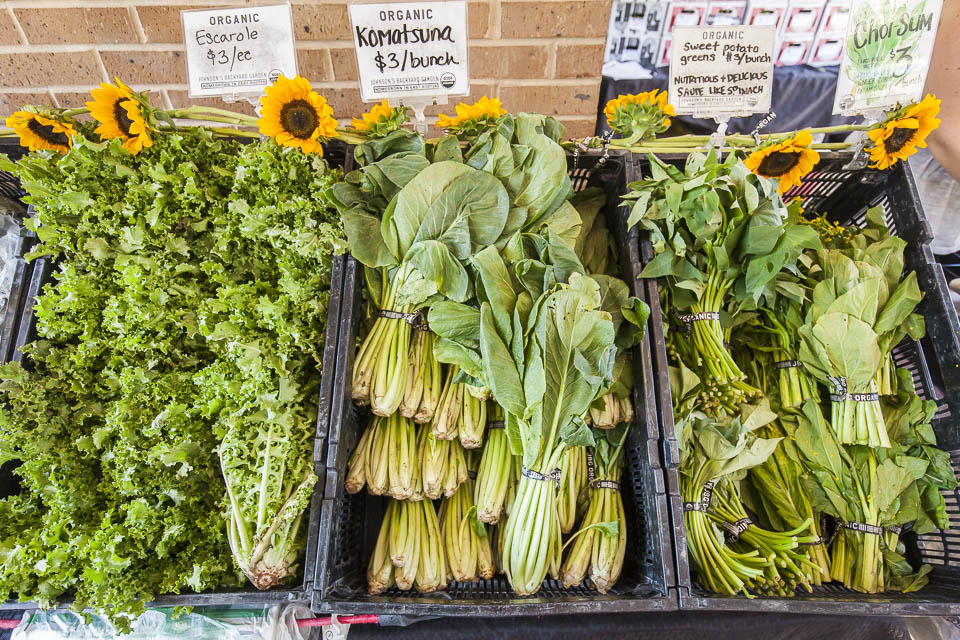 Market greens. Photo by Scott David Gordon.
Market greens. Photo by Scott David Gordon.
We all know leafy greens are healthy... but why? Well, the nutritional value of the spectrum of dark, leafy greens boasts tons of potassium, folic acid, vitamin A, vitamin C, vitamin K, and the list goes on! Vegan or lactose intolerant? These greens are a great source of calcium and iron as well. Chock full of carotenoids, flavenoids + antioxidants, integrating any and all leafy greens into your diet can ultimately aid in immune function, and reduce your risk of heart disease, diabetes, and cancer. With tons of dietary fiber and low in calories, these veggies are great for weight maintenance, too. The USDA suggests that adults consume at least three cups of leafy greens per week, but with all that flavor, why not more? If these benefits aren’t a catalyst for you to step out of your “kale + collards comfort zone” (as Ada calls it) and explore the varying hues of green, we don’t know what else will!
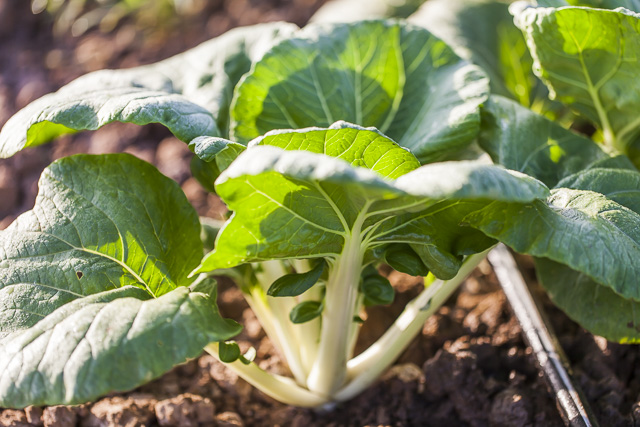 Bok choy. Photo by Scott David Gordon.
Bok choy. Photo by Scott David Gordon.
Bok Choy - Translated directly from Cantonese, bok choy means ‘white vegetable’. Probably the most recognizable of all the Asian greens, this white-stemmed crop is a part of the Brassicaceae family (Fun fact: these guys are relatives of the turnip!) and also a type of Chinese cabbage. If you’ve been to a Chinese restaurant, you have probably seen this green offered on the menu as an ingredient augmenting a meaty dish or sauteed by itself. When cooking, the greens’ texture turns silky and the stems remain pretty crunchy. Ever had baby bok choy? This crop is delectable in any state of maturation. Grab a bunch of these mild greens next time you are at the market!
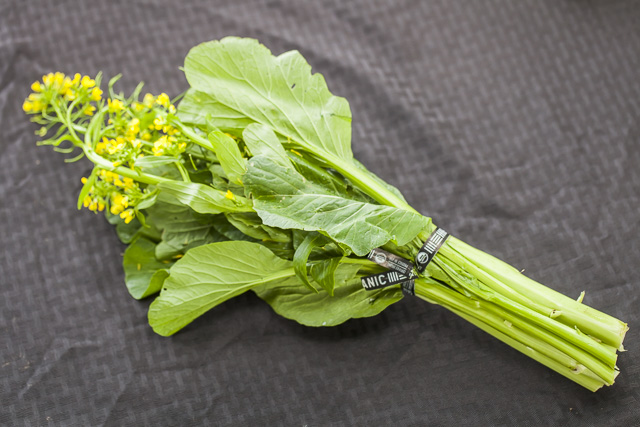 Choi Sum. Photo by Scott David Gordon.
Choi Sum. Photo by Scott David Gordon.
Choi Sum - Identified most easily by it’s dainty (and ever-so-tasty) yellow blooms and long stems, it is also a part of the Brassicaceae fam. Translated as “vegetable stem” from Cantonese, choy sum boasts “a flavor between cabbage and spinach, sweet with a kick” says Mike Mo. A staff favorite here at JBG, this crop is great raw in a salad, stir-fried with other veggies, or a quick saute. If you want to impress your dinner guests, add the flowers to any salad. Not only is it a beautiful embellishment, but also a tasty addition. Check out the Staff Survey below for some recipe ideas.
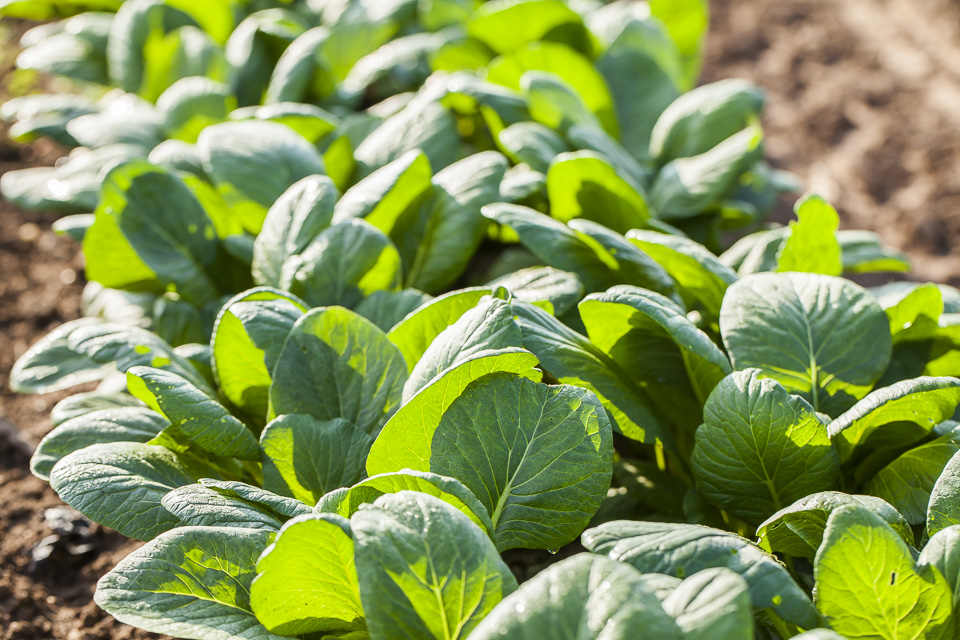 Tatsoi. Photo by Scott David Gordon.
Tatsoi. Photo by Scott David Gordon.
Tatsoi - With an aesthetic similar to that of a baby bok choy, these dark green and very round leaves with their mild taste have become increasingly popular in North American cuisine. Likened to spinach, tatsoi has an almost creamy texture when cooked. This tenacious little crop thrives in cooler temperatures, and can even survive below freezing! Our resident recipe-blogger delved into a cooking escapade with this green last week, check out this simple yet yummy dish!
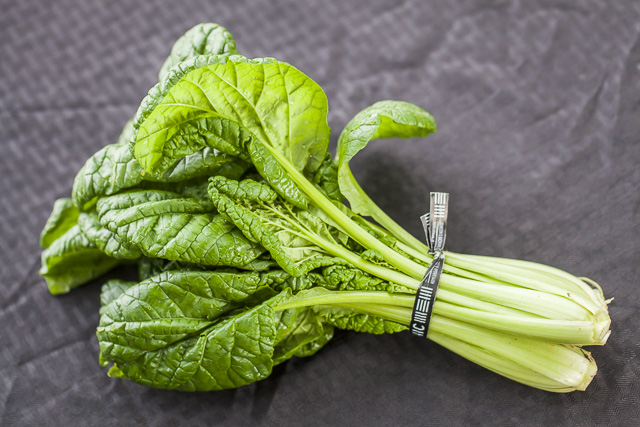 Komatsuna. Photo by Scott David Gordon.
Komatsuna. Photo by Scott David Gordon.
Komatsuna - Hailing from Japan, this crop translates literally as “greens of Komatsu” (fun fact: named after a town that used to heavily cultivate this leafy green in the 1600s, Komatsugawa). Sometimes confused for tatsoi, komatsuna has lighter green and glossier leaves, with thinner and longer stems. Otherwise known as Japanese mustard spinach, this vegetable is great steamed or added to a salad.
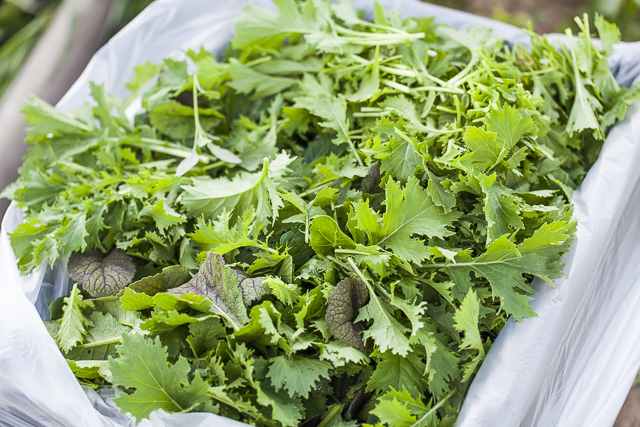 Braising Mix. Photo by Scott David Gordon.
Braising Mix. Photo by Scott David Gordon.
Braising Mix - We know that this little bag of unidentifiable greens can sometimes be daunting, but this mixture of leafy deliciousness could add tons of flavor to a soup, or just dump it out and eat it raw, simple as that! The perfect amalgam of mild and spicy, this power-green combo is a mix of red mustard, green mustard, tatsoi, and Chinese cabbage.
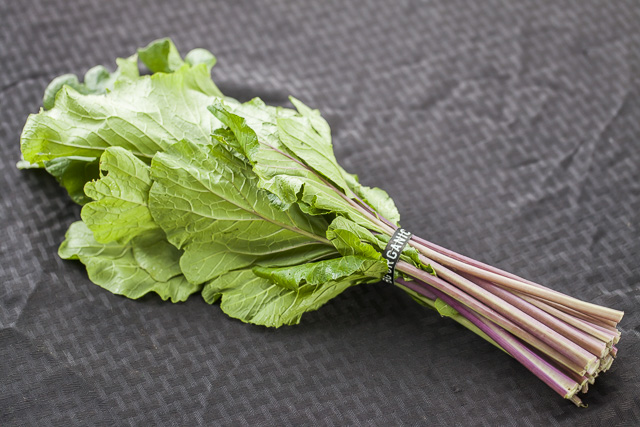 Hon Tsai Tai. Photo by Scott David Gordon.
Hon Tsai Tai. Photo by Scott David Gordon.
Hon Tsai Tai - Identified most easily by it’s long, purple-y stems, hon tsai tai has a slightly sweet, mild taste. Like choi sum, this crop grows beautiful and sweet little yellow flowers that you will sometimes spot when you are sifting through the bin at market. This fun-to-say crop could be the new champion of your signature salad or soup! Give it a try!
Still confused? We hear ya, it can be super bewildering, but hopefully we painted a more understandable picture of the plethora of Asian greens we offer. If you are overwhelmed by all the recipes and are having a hard time utilizing any of the aforementioned greens, just treat ‘em like spinach (that’s what we do)!
 Photo by Scott David Gordon.
Photo by Scott David Gordon.
Staff Survey: What is your favorite Asian green, and how do you use it?
Matt: Choi sum. I was eating the flowers raw last weekend. Tastes like broccoli. Great stir fried with other veggies.
Tracy: Braising mix. On a sandwich with horseradish white cheddar, spicy brown mustard, ham and pepperoni with a generous bed of braising mix. Super spicy!
Ada: Choi sum. Super quick saute, beginning with stems and followed by leaves and flowers. Quick dash of soy, squeeze of lemon, and black pepper. Put on everything, or eat alone. YUM.
Charlotte: I second Ada and Matt! Choi sum, raw or sauteed is mind-blowing.
Ciara Peacock: I like using the big Bok Choy leaves to make wraps, as an alternative to tortillas. So sturdy and flavorful!
Save the date! Don’t miss our CSA Members Only Potluck on 10/22 and a Farm Tour with Slow Food Austin on 10/23!






 0 ITEMS IN CART
0 ITEMS IN CART 

